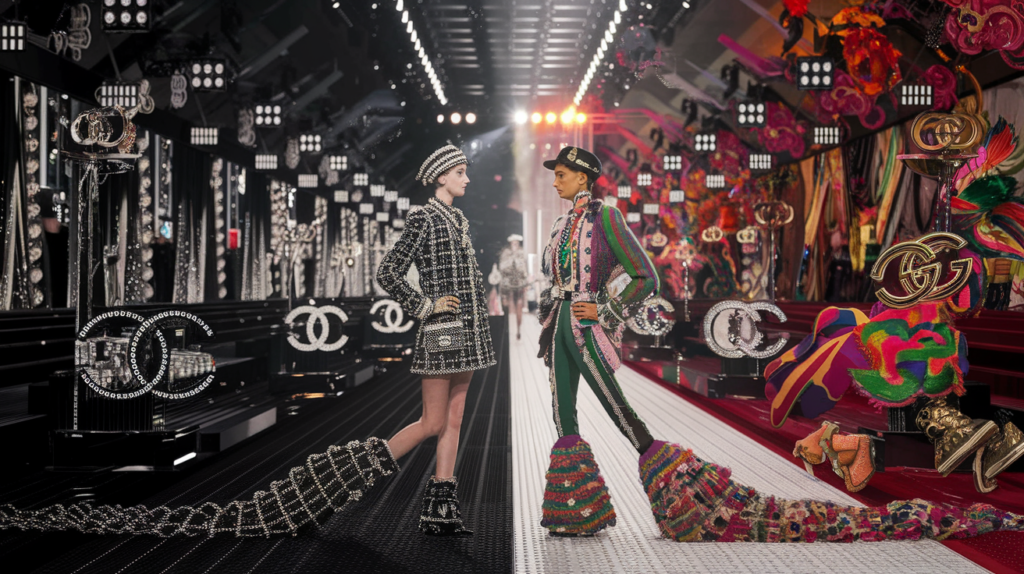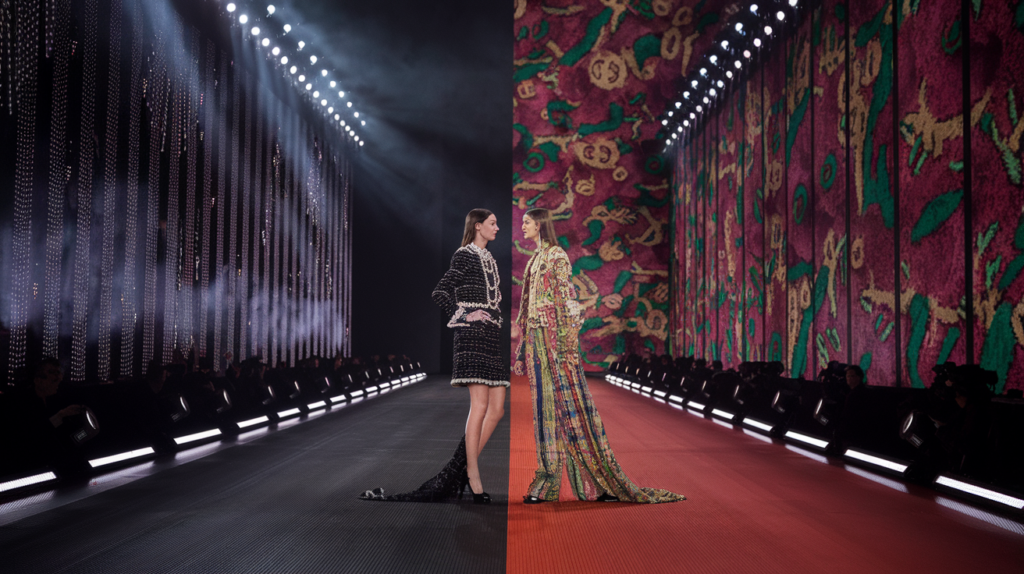
Chanel vs Gucci: A Comparative Analysis of Two Luxury Fashion Titans
There is a select few brands in the luxury fashion world that dominates the industry as much as Chanel and Gucci. Famous all over the world, these brands are more than just businesses; they serve as representatives of various concepts, philosophies, and sophisticated industries. This article explores the historical, design, marketing, and company activity aspects of Chanel and Gucci with the intention of providing a simplified synthesis for industry aficionados and casual observers alike.”Chanel vs Gucci: The Ultimate Luxury Showdown – Latest Trends, Controversies & Future of High Fashion!”
Historical Background
Chanel: The epitome of Timeless Elegance
Chanel was able to first capture women’s attention in 1910, thanks to Gabrielle Coco Chanel and her revolutionary designs that had comfort, simplicity, and beauty stitched into them. The fashion world got completely transformed with the introduction of classic designs such as the little black dress, the Chanel suit, and the 2.55 handbag. Her vision was trying to free women from wearing garments with corseted shapes by introducing a new chick and practical style.”Chanel vs Gucci: The Ultimate Luxury Showdown – Latest Trends, Controversies & Future of High Fashion!”
Gucci – A Family Business Has Built An Opulent Legacy of Skilled Crafts and Artistic Design
Gucci started off in 1921 as a luxury luggage manufacturer commanded towards high-end clientele. Founded by Guccio Gucci in Florence, Italy, Gucci grew in prominence due to its noteworthy expertise for using uncommon materials. Furthermore, they expertly catered to the needs of elite international tourists and the equestrian field. With the passage of time, these brands shifted their focus towards other domains such as fashion, accessories, crafts, and more, but they did not lose their reputation of luxury and flamboyance.”Chanel vs Gucci: The Ultimate Luxury Showdown – Latest Trends, Controversies & Future of High Fashion!”
Design Philosophy and Aesthetic
Chanel: Minimalism that Never Outdated
Chanel has made sure that their elegant taste is apparent in everything they design, and simplicity is at the core of their design philosophy. The brand encompasses a variety of styles with simplistic yet elegant shapes, subtle colors palettes, and classic patterns. Tweed, quilted shapes, as well as the interlaced “CC” logo are constant motifs throughout Chanel’s collections. Her pieces are true masterpieces that remain timeless and stylish regardless of what the trending fashion is at the moment due to her extreme commitment towards refinement.”Chanel vs Gucci: The Ultimate Luxury Showdown – Latest Trends, Controversies & Future of High Fashion!”
Gucci’s Evolutionary Maximalism
Unlike competitors, Gucci explores bold and eclectic visuals as their preference. The brand’s designs incorporate colors, motifs, and a blend or influence of past and present styles. Gucci under the vision of Alessandro Michele directs Gucci to adopt a cross between maximalism blended with vintage as well as a modern take, which gives rise to profoundly culturally referenced yet modern, avant garde collections. Such a combination appeals to multi cultured fashionistas.”Chanel vs Gucci: The Ultimate Luxury Showdown – Latest Trends, Controversies & Future of High Fashion!”
Market Competition and Preferred Customers
Chanel’s Seduction of Exclusivity
Chanel uses directly the utmost level of allure and pride through the image of luxury to entice customers. The timeless appeal of Chanel’s crafted and heritage infused products show the superiority of the brand. Chanel’s customers include those who are well off, possess classic taste and are ready to spend on timeless products. Their restricted availability and set pricing also adds to the overall aura of the brand’s aura.”Chanel vs Gucci: The Ultimate Luxury Showdown – Latest Trends, Controversies & Future of High Fashion!”
Modern Marketing of Gucci
Gucci, despite long holding unto its status, has managed to shift the perception and capture a younger and more heterogeneous target audience. Gucci engages with their Gen Z and Millennial clients by utilizing creative marketing, strategic partnerships, and engaging through digital platforms which ultimately propels brand penetration. Supporting innovative creativeness and diversity allows Gucci to transform into a more contemporary brand in the luxury world.”Chanel vs Gucci: The Ultimate Luxury Showdown – Latest Trends, Controversies & Future of High Fashion!”

Chanel’s New Creative Direction
Belgian designer Matthieu Blazy replacing Virginie Viard as the new Creative Director of Chanel was announced in December 2024. Matthieu brings in new perspective from Bottega Veneta, and this marks a new chapter in the history for the iconic fashion house. His term in office is highly speculated as many experts are excited to witness how he would merge Chanel’s exquisite history with modern fashion aesthetics.
Sustainability Initiatives
Chanel has slowly integrated sustainable processes within their operations. In line with their commitments, the brand has been actively trying to develop materials that will be less harmful to carbon emissions while seeking to attain greater carbon neutrality. Furthermore, these materials also highlight the brand’s aim to be more sustainable. Thus, the benchmark for claiming sustainability is set much higher since the end product should be very extravagant as well as incredibly impressive from a branded perspective.
Gucci’s Eco-Conscious Efforts
Gucci has been an early adopter of sustainability practices in the luxury segment. The ‘Gucci Equilibrium’ initiative aims at minimizing the environmental footprint, strengthening diversity and inclusion within the company, and funding charitable activities. Gucci’s self-imposed transparent reporting on “the goals of sustainability and its achievements” confirms the efforts of “ethical fashion” within the brand.
Consumer Perception and Brand Loyalty
Chanel’s Timeless Prestige
According to consumers, Chanel is the brand that epitomizes modern luxury. The brand’s promise to produce top-of-the-range sophisticated products is well respected, which builds a strong customer loyalty. Strength in maintaining the brand’s image together with deepening fashion activity enables Chanel to remain relevant through time.
Gucci’s Dynamic Innovation
Gucci is well known for their creativity and innovations in fashion. The bold statement pieces designed by the house appeal to clients who are looking for distinct and stylish statement pieces. The brand’s relevance and coverage keeps growing because of the company’s heritage and highly cultural approach to marketing.
Conclusion
Both Chanel and Gucci are recognized as global leaders in the luxurious fashion world, yet they provide consumers with different experiences. Whereas Chanel focuses on refined beauty, exclusiveness, and originality, Gucci captures the world with its versatile, daring, and embracing vision. Both brands seem to be continually in transition as they incorporate new creative and business approaches to sustain their esteem in the fashion world. As these brands adjust to the realities of luxury fashion, Chanel and Gucci reveal the myriad strategies that still work in today’s constantly shifting marketplace.

Frequently Asked Questions (FAQs)
Q1: Why did Chanel close its boutique at the Galleria Department Store in Seoul?
A1: The Gucci pop-up event plan that was set to take place in the department store made Chanel close its boutique as they anticipated it would disrupt the visibility and overall working conditions of their store.
Q2: Who is Matthieu Blazy, and what does he do at Chanel?
A2: Matthieu Blazy is a well-known designer recently engaged as Chanel’s new creative director. He has held a position in Bottega Veneta and is well known for his forward-thinking high quality design.
Q3: What actions are being pursued to combat the increase in theft of luxury items?
A3: In relation to the issue at hand, some undercover operations have been started and, as a result, warnings are being given to proprietors of luxury items to be careful, and auctions have also been held to dispose of seized goods which are reinvested to the state.
Q4: What are the effects of changes in management on luxury fashion brands?
A4: Creative director of any high-end luxury house is a key position. These changes can affect the overall visual identity, assortment, and even brand’s positioning in the markets increasing number of consumers brand may want to reach or keeping loyal ones.
Q6: In which ways social networks are changing the legacy luxury fashion brands?
A6: The online advertising of luxury brands is done primarily on TikTok and Instagram. Social media evaluates Chanel for marketing techniques because of its focus on exclusivity and Gucci because of their viral campaigns and influencer marketing to young kids.
Q7: Gucci’s strategy towards fashion: What is it?
A7: Gucci has been amongst the first to market purchase accessible digital fashion items like augmented reality shopping, NFT, and virtual stores in the metaverse, where consumers can view and acquire digital fashion items.
Q8: Does Chanel and Gucci care about sustainable development?
A8: Yes. Both have sustainability commitments. Chanel focuses more on the carbon footprint and use of sustainable materials while Gucci’s carbon neutrality goal and fur-free collections statement tackles climate action.
Q9: What would be the reasons that Chanel may be regarded as more traditional as opposed to Gucci?
A9: Chanel maintains a unique timeless, elegant brand image that underscores heritage and craftsmanship. Gucci, however, is famous for bold and trend driven designs alongside its nontraditional marketing approaches.
Q10: What challenges face luxury fashion brands today?
A10: As with any other sector, launching and capturing the attention boast major hurdles such as transitioning into the digital sphere, fulfilling sustainability needs, economic changes, and up-and-coming luxury brands competition.

